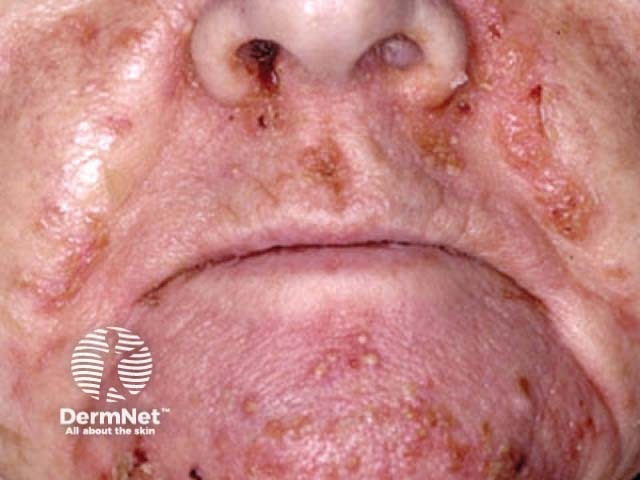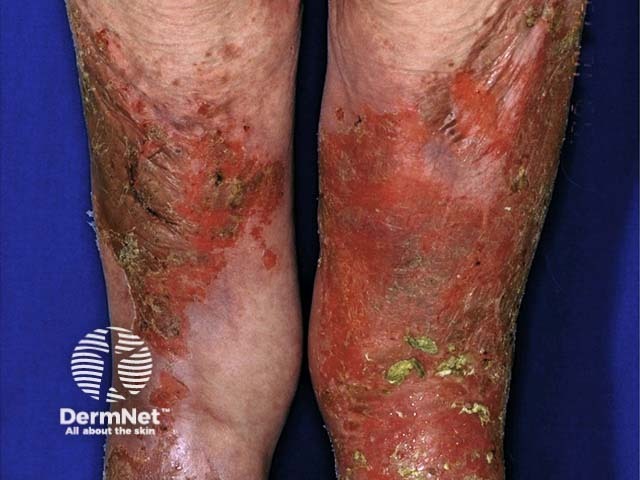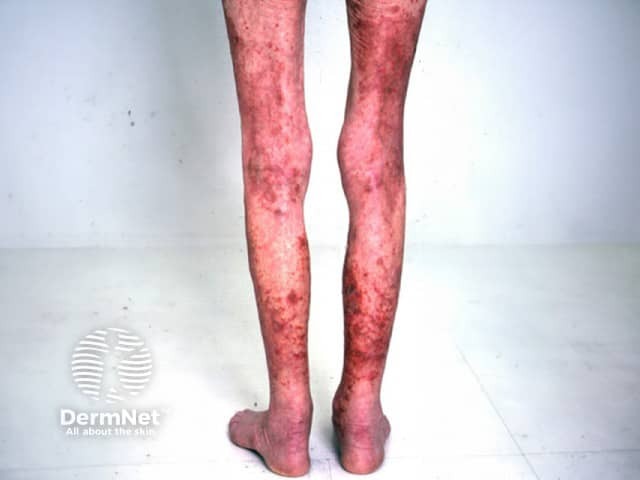Main menu
Common skin conditions

NEWS
Join DermNet PRO
Read more
Quick links
Author: Dr Amanda Oakley, Dermatologist, Waikato Hospital, Hamilton, New Zealand, 2004.
Necrolytic migratory erythema is a characteristic rash usually occurring in the glucagonoma syndrome. Glucagonoma syndrome is due to a slow-growing cancerous tumour located in the alpha cells of the pancreas. Glucagonoma is very rare and affects adults over the age of 50. The tumour secretes excessive amounts of the hormone glucagon.
The results of excessive glucagon also include:
Other medical conditions may result in a similar rash:
Necrolytic migratory erythema may affect any site but it most often affects the genital and anal region, the buttocks, groin and lower legs. The rash fluctuates in severity. Initially there is a ring-shaped red area that blisters, erodes and crusts over. It can be quite itchy and painful. As it heals, it may leave behind a brown mark.
It also results in a sore smooth tongue, a sore mouth, cracked dry lips and ridging of the nails.

Necrolytic migratory erythema

Necrolytic migratory erythema

Necrolytic migratory erythema

Necrolytic migratory erythema

Necrolytic migratory erythema
Necrolytic migratory erythema looks similar to the rash arising in acrodermatitis enteropathica, which is due to zinc deficiency.
It is not known how the rash arises. It may be due to a relative deficiency of zinc, amino acids, or essential fatty acids, possibly because the tumour reduces the amount of albumin that normally carries these around the body.
Excessive glucagon may increase the amount of inflammation in the skin, particularly in friction sites. It also raises the blood glucose, which eventually leads to diabetes mellitus. It destroys protein and fat resulting in weight loss, anaemia and low levels of amino acids.
How is necrolytic migratory erythema diagnosed?
Blood tests may include:
A skin biopsy of necrolytic migratory erythema may reveal inflammation and separation of the superficial layers of the epidermis.
A glucagonoma is usually detected in the tail of the pancreas by computed tomography (CT scan), although conventional chest x-ray, magnetic resonance imaging (MRI) and coeliac axis angiography may also be useful.
Necrolytic migratory erythema usually clears up once the glucagonoma tumour has been surgically removed. However, if the tumour has already spread to other organs such as the liver, surgery is not as effective.
While waiting for surgery, somatostatin, a medication that inhibits glucagon, may be helpful. Zinc supplements can result in complete resolution of the rash in some patients.
Chemotherapy treatments including streptozocin, fluorouracil, dacarbazine and octreotide may also help some patients.
About 50% of patients die within 5 years of diagnosis of necrolytic migratory erythema.